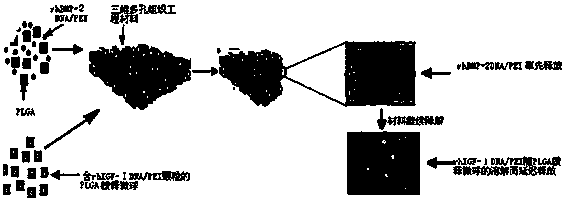A kind of preparation method of double gene sequential slow release tissue engineering scaffold material
A tissue engineering scaffold and double gene technology, applied in gene therapy, pharmaceutical formula, genetic material management system, etc.
- Summary
- Abstract
- Description
- Claims
- Application Information
AI Technical Summary
Problems solved by technology
Method used
Image
Examples
Embodiment 1
[0031] Step 1: Obtain 0.1 g of rhBMP-2 and 0.1 g of rhIGF-I through plasmid construction and amplification.
[0032] Step 2, preparation of rhBMP-2DNA / polyacetimide nanoparticles:
[0033] a. Mix 0.1grhBMP-2DNA and 30g polyethylene oxide evenly to obtain a drug mixture,
[0034] b, dissolving the drug mixture into 50mL N,N-dimethylformamide to obtain a drug oil solution;
[0035] c. Add the drug oil solution to 90 g of polyacetimide ethanol solution with a mass concentration of 60% and a weight average molecular weight of 1000, and continuously stir for 30 min;
[0036] d. Add 40 g of sucrose and freeze-dry it for later use.
[0037] Step 3, preparation of rhIGF-I DNA / polyacetylimide nanoparticles;
[0038] a. Mix 0.1g rhIGF-I and 30g erythritol evenly to obtain a drug mixture,
[0039] b, the drug mixture is dissolved in 50mL tetrahydrofuran to obtain a drug oil solution;
[0040] c. Add the drug oil solution to 90 g of polyacetimide ethanol solution with a mass concentr...
Embodiment 2
[0049] Step 1: Obtain 0.1 g of rhBMP-2 and 0.1 g of rhIGF-I through plasmid construction and amplification.
[0050] Step 2, preparation of rhBMP-2DNA / polyacetimide nanoparticles;
[0051] a. Mix 0.1grhBMP-2DNA and 30g polypyrrolidone evenly to obtain a drug mixture,
[0052] B, the drug mixture is dissolved in 50mL thionyl chloride to obtain a drug oil solution;
[0053] c. Add the drug oil solution to 90 g of a polyacetimide solution with a mass concentration of 60% and a weight average molecular weight of 3500, and continuously stir for 40 min;
[0054] d, add 40g of sucrose and freeze-dry for subsequent use;
[0055] Step 3, preparation of rhIGF-I DNA / polyacetylimide nanoparticles;
[0056] a. Mix 0.1g rhIGF-I and 30g pharmaceutical excipient polyethylene oxide evenly to obtain a drug mixture,
[0057] B, the drug mixture is dissolved in 50mL organic solvent ethyl acetate to obtain drug oil solution;
[0058] c. Add the drug oil solution to 90 g of a polyethylimide so...
Embodiment 3
[0067] Step 1: Obtain 0.1 g of rhBMP-2 and 0.1 g of rhIGF-I through plasmid construction and amplification.
[0068] Step 2, preparation of rhBMP-2DNA / polyacetimide nanoparticles;
[0069] a. Mix 0.1grhBMP-2DNA and 30g pharmaceutical excipient erythritol evenly to obtain a drug mixture,
[0070] B, the drug mixture is dissolved in 50mL organic solvent thionyl chloride to obtain drug oil solution;
[0071] c. Add the drug oil solution to 90 g of a polyacetimide solution with a mass concentration of 60% and a weight average molecular weight of 9000, and continuously stir for 50 min;
[0072] d, add 40g of sucrose and freeze-dry for subsequent use;
[0073] Step 3, preparation of rhIGF-I DNA / polyacetylimide nanoparticles;
[0074] a. Mix 0.1g rhIGF-I and 30g polyethylene oxide evenly to obtain a drug mixture,
[0075] b, dissolving the drug mixture into 50mL N,N-dimethylformamide to obtain a drug oil solution;
[0076] c. Add the drug oil solution to 90 g of a polyacetimide ...
PUM
| Property | Measurement | Unit |
|---|---|---|
| particle diameter | aaaaa | aaaaa |
Abstract
Description
Claims
Application Information
 Login to view more
Login to view more - R&D Engineer
- R&D Manager
- IP Professional
- Industry Leading Data Capabilities
- Powerful AI technology
- Patent DNA Extraction
Browse by: Latest US Patents, China's latest patents, Technical Efficacy Thesaurus, Application Domain, Technology Topic.
© 2024 PatSnap. All rights reserved.Legal|Privacy policy|Modern Slavery Act Transparency Statement|Sitemap

